"Give me a coin. <Takes Coin.> All right. Uh... heads, I win, tails, you lose. Right? <Flips coin.> Tails, you lose." -Ralph Kramden
All things being equal, you're well aware that if you flipped a completely fair coin, you'd have a 50% chance of it landing on heads, and a 50% chance of landing on tails (ignoring the side, of course).

Image credit: C. Nolan, A. Eckhart and Warner Bros. Pictures, retrieved from http://explow.com/Two-Face.
So let's imagine that you flip the coin ten times, and you get seven heads and three tails. Are you worried? You shouldn't be; in order to tell whether a coin is biased or not, you need to build up the proper statistics to actually tell. Flipping a coin ten times, your probability of getting exactly five heads and five tails is pretty small: only about 25%.
So let's say, now, that I do have a biased coin, but it's only slightly biased. Let's say it's biased by just 1%, so that 50.5% of the time, I'd get heads, and 49.5% of the time, I'd get tails. How many flips would I conclusively need to determine whether the coin is biased or not?
Believe it or not, the answer is somewhere around 250,000! A fair coin flipped a little less than that -- ten-thousand times, shown above -- has about a 32% chance of showing a 1% bias or greater in either direction. If you flipped a coin 10,000 times and got 5050 heads, that's what we call a result with 1-sigma (1-σ) significance: something we're not very confident in.
But if there was a 5% bias, if we got 5250 heads in 10,000 flips, that's a very rare occurrence with a fair coin: a result that far off from the expected value of 5000 heads happens only 0.00006% of the time (a 5-σ result) with a truly fair coin. If that was our result, we'd be highly suspicious, and rightfully so, that something was amiss with the coin. We can get that same level of significance for a coin with a 1% bias, but every time you halve the size of the effect, you need to quadruple how much data you take in order to observe it. A coin that was biased by just 0.01% would take more than two billion flips before you could conclude with confidence that it was, in fact, biased.
Now, in particle physics, we don't have heads-and-tails that tell us what we're going to get out when we collide things together; we have the standard model, whose particles are shown above. All of the quarks, leptons, and gluons have been discovered and confirmed, as has the photon and the three weak bosons. The only one not yet discovered is the Higgs.
So, here's the deal. We know -- when we smack any two particles together at any given energy -- we know, based on all the known particles and their properties, how frequently we ought to see all the different types of events that can occur in nature.
So what we do is we compute what the probability of having each type of result is with all the known particles (i.e., without the Higgs), then we do our collisions, record the data, and compare what we get with what we think we should get. The first machine to really get into this game and put something significant out was the Large Hadron Collider (LHC), which released its preliminary results late last year.
How does this work? There are two beams at very high energies rotating and accelerated in opposite directions (clockwise and counter-clockwise), and then squeezed together into a couple of different collision points. The two largest, most sophisticated particle detectors ever built -- CMS and ATLAS -- are centered right around these collision points, poised to observe in gory detail the particle shrapnel that comes out of these miniature fireworks.
And there are plenty of fireworks that come out of every collision. The reason we need that ultra-sophisticated detector is because we want to reconstruct, to the best of our ability, exactly what it was that was created in that collision, with what momentum it was created, and where it originated. Given the complexity of what comes out, it's remarkable that we can do it at all.
Last year's preliminary results from both CMS and ATLAS showed hints of a new particle that would be consistent with a Higgs, but not quite at a significance required to claim discovery.
As you can see, CMS's results, above, show a significant excess over what's expected at an energy of about 125 GeV. The significance is only around 3-σ, not the 5-σ "gold standard" that's required for discovery. But if this is real, we should see something very similar from the other detector, ATLAS. If we can't confirm it with an independent experiment, that's a big indication there's a flaw. (Hi, OPERA!) But when we looked at the ATLAS results, below, we saw that there was no flaw.
Not only did ATLAS confirm what CMS saw -- the same type of signal in the same spot -- they saw it at an even higher statistical significance! Combined, the results from those two experiments could get up to alllllmost 4-σ, edging close to what we could finally call a discovery.
But not quite; we needed more data.
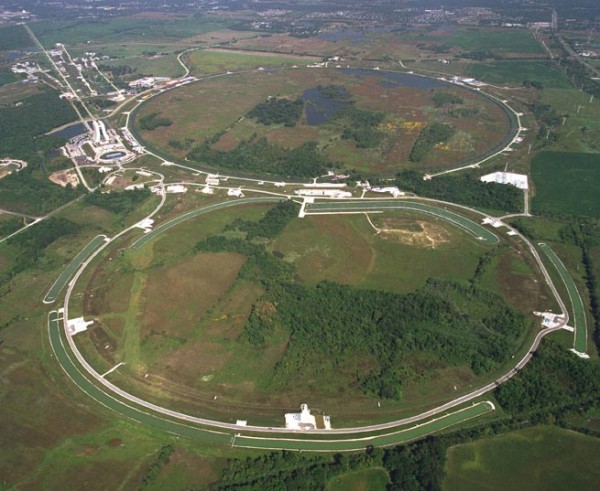
Image credit: the Tevatron at Fermilab, http://www.fnal.gov/.
The Tevatron at Fermilab, above, which was the previous record-holder for most powerful and sophisticated particle accelerator in the world, just released the full, final results from their cumulative data runs, attempting to find the Higgs. What did over a decade's worth of high-energy data (but at significantly lower energy than the LHC) have to show?
As you can see, the blue curves, above, show what the Higgs-less, known standard model background ought to look like. The black points show what the Tevatron has actually observed, and the theoretical Higgs signal -- that tiny extra bit -- is shown in red. When all the data across all the energies is looked at together, we can construct a graph that shows us where there's likely to be a Higgs, if anywhere, based on the data Fermilab has taken.
The final results?
Looks like it's totally consistent with what CMS and ATLAS have observed, preliminarily. The confidence level isn't great -- again, only about a 3-σ significance -- but it wasn't released because it "proves" the Higgs.
It was released because tomorrow -- July 4th -- CERN is set to make a big announcement about the Higgs. And, like everyone else, you know what to expect.
They're very likely going to announce that the 5-σ threshold, the "gold standard" for discovery, has been reached, and that we've discovered the Higgs boson. The only question is whether CMS and/or ATLAS will have enough proverbial coin-flips to announce a discovery on their own (there's a reason it's taken this long), or whether they'll need to combine results to reach that pinnacle. (My money's on the former, which is more convincing, but we'll have to wait and see.)
Assuming things go as we expect, the speculation will turn to the question of what does it mean, and I've got some early analysis for you.
For a Higgs right around 125 GeV, which is where all preliminary analysis points, we expect that the Higgs will be produced at a certain rate, and that it will decay into various other particles at particular rates. What are those rates? There's an excellent analysis in this paper, that shows what the standard model rate is for various possibilities, and what the preliminary data is for each detector, thus far.
If this is, in fact, where the Higgs appears to be, and the rates observed are consistent with the standard model predictions, and there are no other "new particle" announcements that come out on the 4th, then this is an amazing victory for the standard model.
And a nightmare scenario for everything else, including supersymmetry, extra dimensions, and string theory.
Because finding the standard model Higgs at this energy means that there's no need for any of those things. A Higgs at 125 GeV and nothing else at the LHC, totally consistent with the standard model, mean that if supersymmetry exists, it needs to be at such a high energy that it no longer solves the problem it was designed to solve! Despite the absurd claims that others have made, this incredible standard model victory could finally start hammering nails into the coffin of low-energy supersymmetry, which was the prime experimental motivator for string theory in the first place.
So what do I predict we're going to see?
People examining very closely at the individual decay channels of the Higgs, searching for (not yet statistically significant) departures from what the standard model predicts, hoping for the new, beyond-the-standard-model physics that we all hope exists.
But based both on what we've seen so far and what I expect to see tomorrow, I just don't think it's in the data. I'm predicting total victory for the standard model, the most successful theory of all-time. I'll have an update for you if anything new and surprising comes out -- especially if it means something different than what I've written here -- but for real-time news, faster than I can write it, I highly recommend visiting the Particle Physics trap at trap!t that I've built for us.
Happy 4th of July, and here's hoping we can all enjoy the release of the greatest firework of them all.
- Log in to post comments

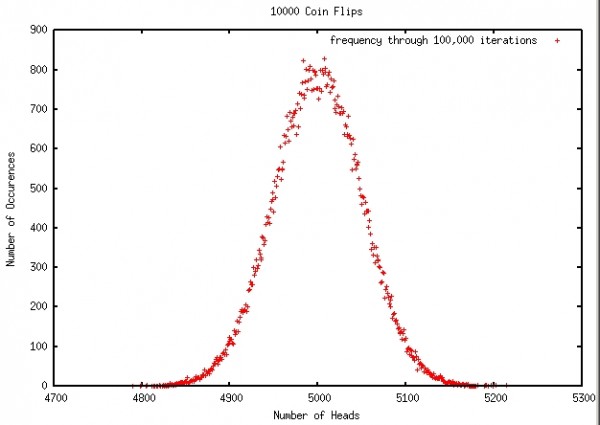

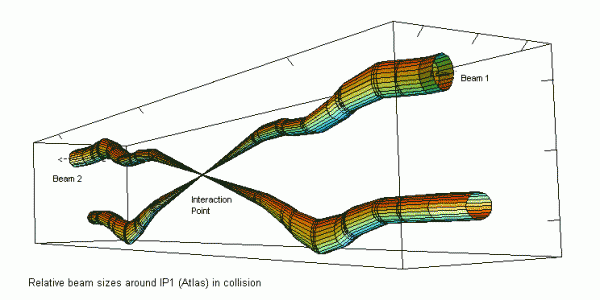
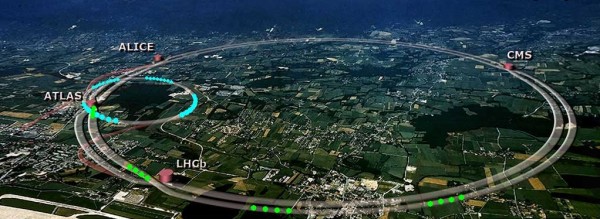
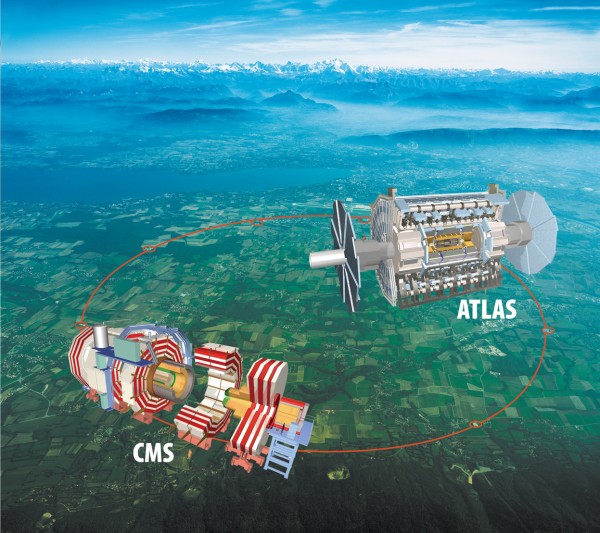
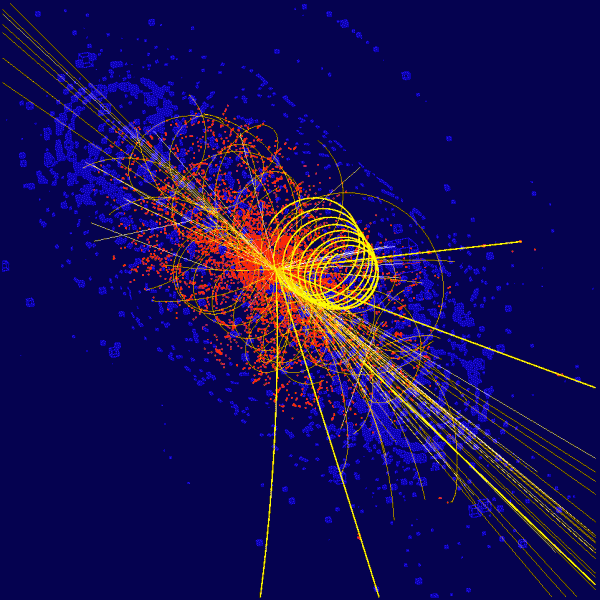

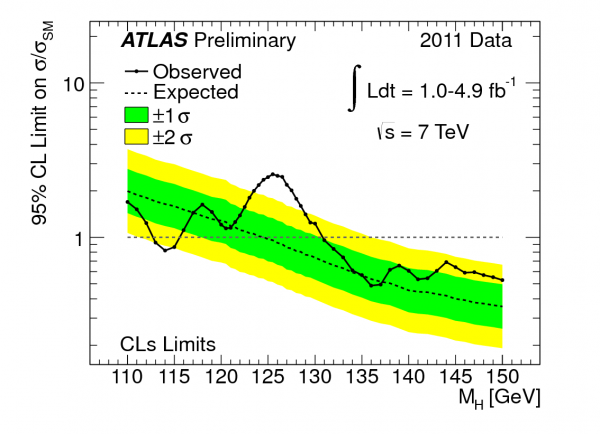
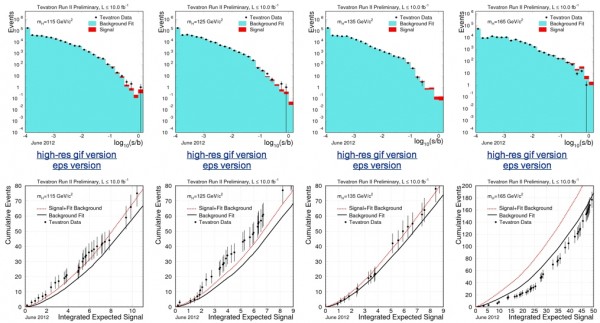




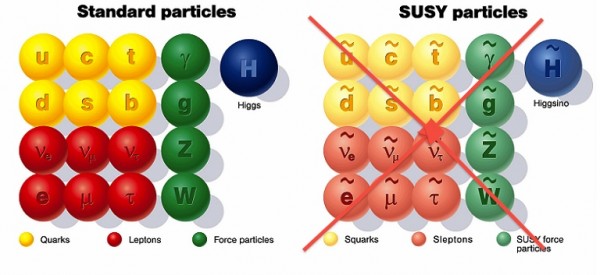

"Higgs boson video leaks to Cern website":
http://www.guardian.co.uk/science/2012/jul/03/higgs-boson-video-leaks-c…
about that fair coin...
http://citeseerx.ist.psu.edu/viewdoc/summary?doi=10.1.1.138.14
Of course there is some confusion circulating about what 5-sigmas actually means, though I expected better from Nature, where this statement appears:
"Physicists have maintained that they will not announce the discovery of the Higgs until the signal surpasses 5 sigma, meaning that it has just a 0.00006% probability that the result is due to chance"
This is the base rate fallacy, as I have written about here. In short, it is confusion between the probability for the data given the hypothesis, P(D|H), and the probability for the hypothesis given the data, P(H|D). These are emphatically not the same.
What I find more disturbing, though, is that there is so much fuss about these silly p-values anyway. I find it strange that such a large group of presumably some of the most capable scientists around can't get their heads together to come up with a posterior probability, which would be far more informative.
I describe why p-values are far less informative than real probabilities in a blog post, The Insignificance of Significance Tests, with an additional helpful thought experiment here, in The Raven Paradox.
Nice try, @anatman. Geeks on the internet are way ahead of those professors: http://izbicki.me/blog/how-to-create-an-unfair-coin-and-prove-it-with-m…
How do particle physicists determine that the signal they see is from a single new particle rather than two or more unknown particles of the same or almost the same energy? Is this based solely on models or is their something in the measurement process that would allow making the distinction?
Anxiously awaiting the news even though I'm now a 24 hour drive from Fermilab instead of a 20 minute drive.
I do have a question about that standard model chart from 1995. Is there a reason that muons aren't shown or was it an oversight by whoever made that chart? At first I thought that they weren't actually discovered by 1995 but it looks like they were discovered in 1936.
Seeing a higgs at 125 GeV is not a nail in the coffin of string theory. That is such an absurd comment.
The fine tuning, aka heirarchy problem, exists, plus dark matter, plus baryogemesis, plus no unification in the standard model, etc, whether you like it or not. The standard model cannot be the final word on nature. If the LHC sees nothing else, then it just means all thst stuff is hidden at higher energies, it doesn't mean that none of that stuff exists. Wow, I've never heard such a bizarre summary of the situation.
Does this mean String Theory is complete rubbish?
Isn't the point that string theory was invented as a speculative idea to explain something which is now explained, thus leaving string theory without a reason for its existence?
@RowdyReptile -- if there are two or more degenerate particles (i.e., same spin, similar branching fractions, etc.) then we certainly cannot distinguish them with a simple mass-reconstruction analysis. In fact, such particles will mix with one another (see, for example, the eta and eta', the omega and phi), and a more complex phase analysis is necessary to see their separate effects.
@ vince whirlwind, that's incorrect. The modern motivation for string theory is that it provides a UNIFIED description of all of physics, including unification of the electromagnetic, weak, and string forces. As well as unification with gravity. It slso provides a quantum theory of gravity. It also incorporates the Higgs mechanism, vector fields, fermions, etc. it also includes chiral fields, etc. Provides vacuum stability, etc.
None of these motivations have gone away now that the Higgs has been discovered, if anything it reinforces its need.
I meant to write..." ...weak, and STRONG forces"
Seems it's confirmed at 5 sigma? Very nice! Science wins again :)
I don’t see how a confirmation of the fifty year old discovery of the Higgs could have any kind of impact on one of the most plausible of the M theories, the Randall-Sundrum theory of warped geometry in extra dimensions.
Although only one sighting has been made of a magnetic monopole, why is it always omitted from all schematics of the Standard Theory? Is it because the Parker Limit makes it absolutely impossible to discover the particle with any kind of sigma level certainty?
In the meantime, despite its disgracefully ignored discovery eighty plus years ago, no one has the faintest idea what Dark Matter is made of. The only things we know about it are some of its properties; that it is: (1) a source of gravity and (2) completely invisible.
Clearing up the DM particle mystery would represent a far more important step forward for science.
One of the inventors of the so-called Higgs mechanism, namely Englert, is a string theorist these days. So its really ridiculous to say that the Higgs kills string theory. It doesn't. Its inventors don't think so. If anything, it supports it, because the Higgs mechanism is precisely what appears in string theory as the mechanism to break the electroweak symmetry.
They found it, it exists.
Higgs boson-like particle discovery claimed at LHC
http://www.bbc.co.uk/news/world-18702455
Sorry, guys, but the argument of "the fact that we found nothing to corroborate string theory just means the string theory is hidden in higher energy levels" seems to me like... RELIGION argument.
This behavior pattern is the same found in religions. Every time science proves wrong some religious belief, the religious guys push his believes to the next unknown level.
This way, it's impossible to prove them wrong. If tomorrow, a 100 fold stronger particle collider is built and if it finds no evidence of string theory. Rather than admit there's something wrong with string theory, all you have to do is to push it to higher energy levels.
I know how interesting string theory is, but it's time to recheck the theory's fundamentals...
Its funny how ChicoPinto provides a quotation that nobody actually said, and then goes on to compare this fictional quotation to religion.
Detecting a Higgs at 125 GeV is perfectly fine as far as string theory is concerned. It is just wrong to claim that it kills it. Its not supported by any papers, no-one in theoretical physics would support this claim. If you hate string theory, fine. But claiming it is wrong because the higgs exist, which is a part of string theory, is just crazy.
Question: How can we say the new 125 GeV result confirms theoretical predictions if they were searching a broad area of energy spectrum for it and large areas ware had to be excluded? If theory had predicted it at 125 then why wasn't the search done right at that spot? Did the theory not actual predict 125 but merely 'high' mass? This seems contrary to earlier searches ware mass was predicted and searching was done at that point with success.
Bob:
What would you accept, then, as proof that string theory is wrong? I'm not taking a position on whether it is or isn't, but I'm asking what YOU think would be proof that it is absolutely wrong and cannot possibly be true at any energy level.
Follow up: Given the fact that a large energy range was searched and the graphs you provide track the Sigma significance of the signal across that large range. Isn't our final confidence significantly lower then the sigma at the highest point because we have to account for the probability that a false positive would have occurred some-ware over that range? For example if I take a bag of 100 pennies which I believe has 1 unfair penny. I then test each one individually with a number of flips that would give a 5 sigma confidence of its fairness. And one penny is found to be not-fair then my confidence can't be 5 sigma that I was right about their being 1 unfair penny, it's got to be significantly lower due to the cumulative false-positive potential across each penny test.
"How do particle physicists determine that the signal they see is from a single new particle rather than two or more unknown particles of the same or almost the same energy?"
By looking at the consequential results.
Example. Someone has been hit on the head by some heavy object whilst walking under a ladder.
It could be a paint tin or a loose brick. But when you wake up you see a paint pot. It could be that didn't actually hit you, but was on the floor all the time. So you check it for dents with your blood on them and spilt paint on your head. If none are found, you know your hypothesis is wrong.
Even if you do find it, you don't *know* that it didn't happen that way, but you're pretty darn sure it wasn't a brick that someone later took away.
Dante: "What would you accept, then, as proof that string theory is wrong?"
That isn't what Bob;s saying. he's saying: "But claiming it is wrong because the higgs exist, which is a part of string theory, is just crazy."
You need to counter the claim made, not a different one.
But if string theory also has a Higgs boson, then the statement that the presense of a Higgs boson is proof that string theory is wrong IS WRONG.
Asking what would disprove would be "evidence for the existence of something that precludes String theory being correct", which still leaves Bob's statement correct.
"Sorry, guys, but the argument of “the fact that we found nothing to corroborate string theory just means the string theory is hidden in higher energy levels” seems to me like… RELIGION argument."
That, however, was the argument for the Higgs Boson and standard model to be kept until this result proved it.
Several colliders had attempted to look for the Higgs at lower energies. When it wasn't found, the response was "Well, maybe the Higgs exists at higher levels".
String theory defence is doing the same thing.
If String theory had predicted that there MUST be some effect by now, then it would have to be changed. Just as if the Higgs hadn't been found (the standard model would have had to be modified or abandoned in that case).
"Isn’t the point that string theory was invented as a speculative idea to explain something which is now explained"
No.
:-)
Though Bob's comment here : "The standard model cannot be the final word on nature. " isn't entirely right either. Those problems show that the Standard model AS IT CURRENTLY IS FORMULATED is not sufficient. This doesn't mean it can't be made to cover those issues, nor does it mean that string theory is right.
All it tells us is that the standard model as currently formulated doesn't explain dark matter/energy/quantum gravity and so on.
I hold out that this proof of the standard model will allow us to test consequences that will help us explain where (then why) these discrepancies appear. That's when we can start to explain them.
So.... what gives the Higgs boson its mass?
The Higgs Boson.
The mass of the Higgs particle is given as energy for a good reason.
It's how much energy you need to give to the Higgs field to get one of the virtual particles out of there and into reality.
And that's 125GeV.
Because of e=mc^2 this energy can be expressed as mass.
And when it is real and torn out of the field, it too will be dragged back by the virtual particles in the Higgs field.
Wow:
You've missed the point. Here is the thread I am following:
"If the LHC sees nothing else, then it just means all thst stuff is hidden at higher energies, it doesn’t mean that none of that stuff exists."
"Sorry, guys, but the argument of “the fact that we found nothing to corroborate string theory just means the string theory is hidden in higher energy levels” seems to me like… RELIGION argument."
"Its funny how ChicoPinto provides a quotation that nobody actually said, and then goes on to compare this fictional quotation to religion."
Does that clear it up? Bob is (understandably) offended at ChicoPinto's statement, but instead of refuting it, he just handwaves it by declaring that it's a paraphrase rather than an exact quote. I'd like a refutation. It's his choice whether or not to do so. He doesn't owe me anything.
OK, the bit "all that stuff is hidden at higher energies" is wrong. But "it doesn't mean that none of that exists" is wrong too.
Chico's argument is scientific fallact because you need to find something that contra-indicates the theory.
Just as happened with the Higgs Boson with earlier colliders. IIRC the median expected size was 80GeV and they'd looked to about 100GeV and not seen it. though precluding most of the possible values under the standard model, the standard model wasn't disproved by this result.
No more is string theory because of the same reasoning.
Chico's point was absence of evidence == evidence of absence.
You're also missing your reply had nothing to do with Bob's statement, but was a rehashing of the same " absence of evidence == evidence of absence" fallacy.
Wow:
ChicoPinto's argument does not, to me, seem to be anything of the sort. Mainly this is because many scientific theories are not abandoned because they are proven definitively wrong, but rather because a different one that provides a more complete and elegant answer gains evidence and acceptance.
You're right that absence of evidence is not evidence of absence, but science doesn't stop there. The difference between science and religion is falsifiability. I'm asking for the demonstration of falsifiability. What would Bob accept as proof that string theory is false? If he can't name anything (and if you can't name anything either) then "religion" is a good word to apply.
I'm not asking for you to provide counter-proof. I'm just asking Bob (or you, if you'd like) to describe what counter-proof you would accept.
That would explain why you made the same mistake he did, Dante.
Your response was a non-sequitor. Get over it.
Love the chromostereopsis on that first image! (The reason it looks 3D.)
Yet again a win for science, awesome stuff. They built the world's most powerful microscope and, sure enough, there was indeed more to see - just as they predicted.
One question though - if the larger-energy particles like Top rapidly decay into smaller, more stable ones, why are they considered to be fundamental and not just pumped-up composite giants instead?
Dante, earlier in this thread, I stated "The fine tuning, aka heirarchy problem, exists, plus dark matter, plus baryogemesis, plus no unification in the standard model, etc, whether you like it or not. The standard model cannot be the final word on nature. If the LHC sees nothing else, then it just means all thst stuff is hidden at higher energies, it doesn’t mean that none of that stuff exists."
I never said there was proof that string theory exists at higher energies. I am making the point that there are many features of the universe that need to be explained in some unified framework. So what is that framework? All I am saying is that string theory might be it. Ethan's post claimed that because we've found the Higgs, therefore string theory is wrong. The Higgs is part of string theory, so the only thing that has shown to be wrong is Ethan's reasoning. I don't get what is so confusing about this.
Kenny, we did not know a priori what the Higgs mass would be, so a range of mass was explored, but its mass, and only its mass, was left unknown. What the theory did do was make the following predictions: (i) that a new particle would exist, (ii) its mass would be of order the electroweak scale, (iii) it would be a boson, (iv) it would be spin zero, (v) it would be produced by proton-proton collisions with a particular cross-section, (vi) it would decay to 2 photons with a particular rate, (vii) it would decay to 2 Z-bosons with a particular rate, (viii) it would have smaller decays to other channels, etc, (ix) it would correct precision electroweak observables by a certain amount. All of these predictions are in good agreement with observation. The details need to be ironed out, such as if there is an excess into 2-photons. But the fact that a new spinless particle has been found is very clear, and it is consistent with the SM Higgs.
Kenny, your second comment refers to what is called in the business the "look elsewhere effect", which, as you say, lowers the statistical significance of the discrepancy from the null hypothesis. Of course it is well known and taken into account in the analysis.
@Kenny / 6:29 am
"How can we say the new 125 GeV result confirms theoretical predictions if they were searching a broad area of energy spectrum for it ..."
If I predict that a pig has a tail at the back, than it doesn't really matter what its precise position is relative to its rectum, as long its at the back and its curly than it is good enough :mrgreen:
Wow:
Your apparent belief that a request for falsifiability constitutes a non-sequitur tells me everything about you that I think I need to know. You can respond to me if you like, but I don't feel any further need to respond to you.
Bob:
"I never said there was proof that string theory exists at higher energies."
I didn't say you had said that. And I understand why you were upset at being accused of moving the goalposts, as you were.
But I'd like to know what you'd accept as falsification of string theory. The Higgs is not it. But what is? I am curious.
Bob, the point was that saying "they are at higher energies" (paraphrase) it implies that they do exist.
"The phenomena supporting string theory may still yet be found if we move to higher energies" is much closer to how the situation will resolve itself.
It becomes clearer what needs to be done to show string theory in need of revising.
Dante, you seem to misunderstand. I only wanted to make 2 main points:
1) The Higgs mechanism is part of string theory.
2) The Standard Model is NOT the final word on nature. Why; because in the SM there is no dark matter, hierarchy problem, strong CP-problem, no unification, non-renormalizability of gravity, no baryogenesis, no inflation, etc. So it is missing a lot of stuff that exists in the universe. Our goal as scientists is to find out the explanation to those things. You can't dismiss those things because the LHC didn't see new particles yet at low energies. Those problems don't vanish just like that; you need to discover new physics. I don't know what that new physics is. It may be string theory, it may not be. String theory is the only framework known that unifies and incorporates all these features of the universe. That is why it is interesting.
As to how do you falsify string theory? That is a tough question. But there are many ways; for instance, in string theory the Lorentz symmetry is exact, unitarity is exact, equivalence principle is exact, uncertainty principle is exact, causality is preserved, etc. And violation of those things would falsify string theory.
But the issue of the falsifiability of string theory is besides the point. I simply want to say that there is a lot of beyond the SM questions left about the universe, and we need to figure out the answers. If the LHC can't answer these questions, because it only see SM effects, then this reinforces the need to push with developing theoretical models, rather than throwing them away arbitrarily as this blog tried to do. If you throw away our best theoretical ideas as to how to unify physics, and we don't have guide from experiment, then what do you have left?
Actually, let me update my first point:
1) The Higgs mechanism, and the entire Standard Model, is part of string theory.
Bob:
The thing is that I don't think Ethan, or anyone I think (at least where I can see it) has argued that the Standard Model explains everything. That's part of the reason why people keep experimenting, observing, and theorizing. There are holes that need to be filled.
And, as far as I've been able to tell, Ethan's dislike of string theory stems from its inability to make testable predictions. A theory fails if it doesn't make testable predictions, because that means that it isn't contributing to our understanding of reality.
I actually like string theory, a lot, and when I was younger and it was newer I sort of fell in love with it. But it really hasn't gone anywhere.
Ethan also didn't say that the Higgs was the coffin nail for string theory. He says that the existence of the Higgs shows that the more exotic models like SUSY and string aren't necessary, and he makes some particularly damaging remarks about SUSY now being impossible (but leaves string mostly alone unless I'm overlooking something).
It may be that string goes the way of the cosmological constant, where it is laughed out of Dodge for 50 years and then people start coming back to it with a new way to define it and there seems to be something in it now. But for now, string doesn't seem to contribute much.
I appreciate your response and your list of things that you would believe would falsify it.
Dante, sorry, but your response is illogical:
On the one hand you are saying that the problem for string theory is that it doesn't make any predictions, and therefore it is not falsifiable.
On the other hand, you are saying that the existence of the Higgs falsifies SUSY and, by association, strings (where Ethan says "which was the prime experimental motivator for string theory in the first place").
So the points are completely incompatible and ridiculous.
Dante, you are wrong in saying that Ethan didn't argue that the Standard Model Explains everything. To the contrary, he says that if the Higgs is found then there is no need for new physics; his words are "Because finding the standard model Higgs at this energy means that there’s no need for any of those things".
My point is that this is 100% wrong.
this must be the only blog on the web claiming that the discovery of the Higgs kills susy and string theory. unbelievable claims. Both SUSY and string theory predict the existence of the Higgs field. So how can a discovery of the Higgs falsify it?
and then to also claim that string theory is not falsifiable. holy moly, this is so illogical.
Bob, one, that would be the posters, not the bloggers. Two, it's not the only one doing so.
And it's OK in a layman's sense to say so because string and standard model are competing theories and support for one canbe intuited (admittedly not scientifically rigorously) as support against the other.
Bob, there is no need for new physics because what the standard model explains is confirmed, whilst string theory's conclusions that depart from the standard model haven't been confirmed.
You, now, are doing what Dante etc all are doing. Just the opposite way. String theory is not proven a better explanation of reality than the standard model and saying the standard model doesn't explain certain things doesn't change that fact.
I don't believe they have solved anything. The problem still remains because of the "Observation issue". Particles behaves differently when being observed. As such, they are trying to predict the behavior based on observation. There are something science cannot explain by observation alone, and this is one of them.
It's very nice when a theory explains something.
So let's all applaud the standard model and the Higgs or Higgs-like discovery. Bravo. Great work.
But as our "knowledge" becomes more precisely correct, i.e. approaches "truth"; our "ignorance" becomes greater, i.e more and better questions. We never reach the point where we know what we know and that's all there is to know.
Thus a "proven" "correct" theory is not always the best theory to guide to fundamental research (into the unknown). So if standard model can suggest no further experiments for the LHC; then experimental physicists must look to "unproven" theories for guidance.
The value of string theory (of any unproven theory) is that it brings excellent questions and possibilities to the physics discussion. And as long as string theory provides insight with which to grope our way towards understanding the "unknown"; then it is a scientifically useful theory and an active field of scientific research .
The LHC is the most powerful physics machine on the planet; if string theory comes up with a good experimental question; it will be tested. The discovery of the Higgs is just another boundary condition that needs to be accounted for by any successful string theory.
> Chico’s point was absence of evidence == evidence of absence.
FWIW, absence of evidence, particularly when you've been looking hard for evidence, is evidence of absence. It's just not proof of absence. Failure to find the Loch Ness Monster doesn't prove there is no monster, but it sure is evidence there is no monster. The fact that there's still some corner you haven't looked in yet doesn't mean the evidence of absence you do have isn't helpful.
Okay, cut all the theoretical physics and speculative fictional crap and come out and say it...CAN YOU MAKE IT EXPLODE LIKE FIREWORKS?
CAN YOU MAKE A 10 BILLION DOLLAR BOMB FROM THESE RESEARCH FINDINGS? These "geniuses" are incredibly reckless with all life on this planet.
No, OKThen.
You seem to be a little confused.
First you say as we go through proving things (our knowledge of what's true increases) we get more questions to answer.
Then you say that as we progress the knowledge of the standard model, we have no more questions to answer.
These are self-contradictory.
Deborah, take anything that you read that is written by Dan Brown with a really big grain of salt.
Yes our knowledge has increased.
The standard model predicts a Higgs particle and we have found a Higgs-like particle. Thus the Standard Model has been tentatively "proven". Nothing is ever finally and fundamentally proven.
Newtonian gravity has been tentatively proven for a certain domain of validity. We know that domain of validity better today than Newton did.
Likewise today, the last particle of the Standard Model has been disocvered and in that sense the standard model has been proven. All proof is tentative. And further we do not know very well the domain of validity of the standard model.
For example does the standard model of particle physics include the graviton? Well not as an elementary particle.
And "the Weinberg–Witten theorem (WW), proved by Steven Weinberg and Edward Witten, states that massless particles... the graviton (j = 2) cannot be a composite particle in a relativistic quantum field theory".
So the Standard Model may not even allow the graviton as a compoisite particle, e.g. a glueball;however,.. "it is possible to have a composite/emergent theory of massive gravity."
So what does this mess of our little understanding of the graviton have to do with the discovery of the Higgs?
In my mind, the discovery of our Higgs-like particle has further constrained our lack of understanding of the graviton. Such constraint always increases the quality of our ignorance and allows our speculation to delve deeper into the possible speculations.
No more time. But you are correct, I am self contradictory; but who isn't Godel, Wow, Ethan, who?
For those who are not experts, ket me explain something very important here:
Why is there a Higgs boson? Well, you can write down a Higgsless Standard Model; it is a theory where particles have mass, etc, and the electroweak symmetry is broken, etc. All the things that the Higgs-field does. So why do we need the Higgs boson; an excitation in this field?
The answer is: because it restores UNITARITY to the theory. Without the Higgs boson, the high energy scattering of W-bosons would violate unitarity.
Ok, so we have 2 possible theories:
1) Standard Model with no Higgs boson which violates unitarity.
2) Standard Model with Higgs boson which respects unitarity.
Which does nature choose? Does nature respect unitarity exactly or not? If no Higgs boson exists then unitarity would be broken.
So which did nature choose; well LHC has proven it chosen 2). Nature respects unitarity.
Which of the 2) did string theory predict? Answer 2), because string theory respects unitarity exactly.
To be clear: String theory predicts the existence of the Higgs. Anyone claiming that the discovery of the Higgs falsifies string theory is a crackpot.
Finch, the point being is we haven't looked everywhere yet.
It's like looking for your lost keys in your coat pocket, and then saying "I haven't found the, they must have been disintegrated".
The significance of the number 125 and its association with the Higgins boson REALLY deserves more focus...
When a single quantity multiplies in order to accumulate (2 * 1 = 2), another simple equation representing how that is possible is 2/1 = 2. Obvious.
What is interesting is the reverse of that latter fraction: ½ = .5, and if you multiply the numerator and denominator, you never end up with a sum ending in a five no matter how many times you keep multiplying; such an asymmetry between multiplying and dividing only ever happens with fractions having denominators that are a multiple of 2.
My point: what if the expansion of existing numbers at the very creation of the universe was not linear? After an existence of nothing but 0, first 1 existed, then 2, then 5 (it had to exist if .5 existed, and before 3 came into the picture, because the ability of numbers to multiply and divide into each other precedes the ability to add and subtract them; this also follows because either multiplying or dividing 0s, 1s, 2s and 5s against each other always results in ending digits of 0, 1, 2 and/or 5) Certainly, a particle central to the creation of the universe would exhibit a behavioral bias towards the first whole number containing the first three non-zero numbers to exist (and in sequence), in order to be inclined towards perpetuating the beginnings of existence in the first place. Given the necessity of the nature of mathematics to be congruent to any true understanding of the universe which involves it, the fact that the Higgins boson has such a connection to this unique number should not be easily dismissed as some mere coincidence, because it would be one hell of a coincidence.
Here is the reasoning for my hypothesis above (to understand this chronology clearly, all you need to understand is the order of operations that deals with division/multiplication of existing numbers first, then subtraction/addition of existing numbers, then division/multiplication that results in new numbers, followed by subtraction/addition that results in new numbers):
Starting Point: There Is No Universe Yet and Zero Is The Only Number That Exists
Step A: 1 comes into existence, now 0 and 1 exist. 0 / 1 = 0, 1 x 0 = 0, 1 * 1 = 1; all possible divisions and multiplications with this number set is now exhausted, and 0 and 1 remain the only numbers in existence up to this point. Now comes addition in our order of operations…
Step B: 1 + 1 = 2, meaning that now the numbers 0, 1, and 2 exist. (With a new number set, we must restart our order of operations from the beginning before we would continue any addition equations using the old set, so there is no 2 + 1 giving us 3 yet, for instance; however, before we can use this new set of 0, 1, and 2 to create additional numbers even using multiplication - i.e. claiming 4 exists at this stage because 2 * 2 = 4 - we must instead first compare the numbers in our set to see how they divide into EACH OTHER, under the reasoning that ratios between already existing numbers are necessary for their existence to hold, and therefore are the first thing that must be in place before any additional numbers could reasonably be added to existence considering they rely on compiling or decompiling the current numbers based on those aforementioned ratios)
Step C: 1 / 2 = .5 is the only new result we get at this stage, but that now means the number 5 now also exists by definition, so that means the digits 0, 1, 2, and 5 now exist. (Once again, to work with this new number set going forwards, we must again restart our sequence of operations from the beginning, which as stated means a comparison of existing numbers before we attempt to use them to make new ones; in this case we cannot yet say 10 exists because of 2 * 5, we must examine ratios that separate 2 and 5 FIRST)
Step D: 5 - 2 = 3 and 5 - 1 = 4, so now we have digits 0, 1, 2, 3, 4, and 5 in existence, as the numbers 3 and 4 now exist (through the only applicable use of adding/subtracting at such a counterintuitively early stage in operations: comparison of existing numbers in the set, as they must be some fixed increment from each other to continue to exist and logically those increments must have SOME value. Now, with our new number set, we restart operations once more, yet again beginning with comparisons of existing numbers first to identify already existing ratios.)
Step E: 1/5 = .2 and 2/5 = .4 and 5/2 = 2.5. This gives us 0, .2, 1, 2, 2.5, 4, 5, and 25 as existing numbers, and our digits are now 0, 1, 2, 4, 5 (again with a new set of numbers, we again must restart the order operations, first considering existing ratios)
Step F: 3/5= .6 repeating and 4/5 = .8 and 5/3 = 1.6 repeating and 5/4 = .125 - the latter simultaneously also creating the noteworthy number 125, as well as both being the first numbers in existence to have three different digits in them - on top of the fact that those digits were the first non-zero numbers to exist.. Existing digits now include 0, 1, 2, 4, 5, 6, and 8, and existing numbers now include 0, .125, .2, .6 repeating, .8, 1, 1.6 repeating, 2, 2.5, 4, 5, 25, and 125 (as much of a pain as it sounds like, we yet again restart operations with the pleasure of comparing all of those numbers against each other)
Step F: While a lot of new numbers popped up into existence, most just use the same digits; the only NEW digit to pop up from all those comparisons is 3, as in 2 /.6 repeating = 3. Yes, it took us this long to introduce 3, and we got to that special 125 figure FIRST.
Step G: With all the ratios accounted for there are no new digits, leaving us to multiplication and division of our most recent number set, which introduces the integer 9, as well as the decimal .75, giving us the only digits we were missing (7 and 9).
The point is we needed 125 to exist before 3 could exist, before 7 could exist, and before 9 could exist – we needed it for the universe to be created, for enough cohesion to allow the process to take hold, instead of the universe crumbling apart the same instant it appeared. The idea that this number has a correlation to the Higgins boson should not be a surprise; it should be an epiphany.
I erred in my last post by not realizing I had found 3 in Step D before finding it again in step F, sorry everyone.
Therefore, 125 does not come before 3 in the creation of numbers - but it still does come before 7 or 9 in that chronology of existence, which is still remarkable and the broader point of non-linear wonder and the importance of 125 is still the same.
wow said:
> Finch, the point being is we haven’t looked everywhere yet.
I agree with that point, but earlier you said: "You’re also missing your reply had nothing to do with Bob’s statement, but was a rehashing of the same ” absence of evidence == evidence of absence” fallacy.""
It's not a fallacy. It's a truth. Absence of evidence is evidence of absence. String theory took a hit with this news. It wasn't a particularly big hit, as you point out there are other places to look, but it was a hit.
Finch, you are 100% wrong. String theory predicted the Higgs would exist.
ShadowSD, you are obviously a crackpot. There is NOTHING important about the number 125. The fact that the Higgs mass is near that is due to an arbitrary choice of units. Its amazing how many ignorant people are at this blog; it seems to set a very low standard.
"It’s not a fallacy."
IT IS a fallacy.
You have to have expected evidence before it stops being a fallacy.
Take, for example, the existence of God.
Given the powers and motives he is claimed to have had by mainstream christianity and his attributed past actions, along with his current stated opinion and the evidence of the mess people are making of "His word", and our many and varied attemtps to see Him at His word, we should have seen some evidence of his actions.
Therefore "where is the evidence for your god" is not a fallacy.
However, since we aren't looking in the right places for the differences between string theory and the standard model and that where we HAVE looked, they would be indistinguishabe, then saying "where's the evidence for string theory" is a fallacy, since the evidence we currently have is in accord with it, and we haven't even tried to find the evidence of the departures.
"However, since we aren’t looking in the right places for the differences between string theory and the standard model and that where we HAVE looked, they would be indistinguishabe, then saying “where’s the evidence for string theory” is a fallacy, since the evidence we currently have is in accord with it, and we haven’t even tried to find the evidence of the departures."
My understanding is that a Higgs with mass significantly different from what has been found could have been evidence of low energy supersymmetry. This wasn't found. It's a small negative for string theory. Clearly there may be many other possible worlds consistent with string theory. I thought Ethan's language was too strong.
> "IT IS a fallacy."
Saying it more loudly doesn't make it true. We could have found evidence of string theory here, and we didn't. But I don't think most people really expected to.
And if your eyesight were better, you'd see that there was more, than "IT IS' to it.
Look, you,re dragging this down into the dumb ass gutter which you have far more familiarity with than me.
It is a fallacy. It is, like many, dependent on usage, but the usage here is fallacious.
Hell, he and you are just plain wrong: the presence of the highs boson is evidence supporting string theory, hence "there's no evidence for string theory" is just plain wrong.
It was possible string theory could have given us a different Higgs from the one we observed. It didn't, and that was too bad. Look, I agree, it's a minor negative.
But saying it's not a negative is just taking leave of reality.
I'm not trying to advance some crackpot theory here. We could have seen evidence of string theory here, and we didn't. We didn't see anything particularly damning either.
I went to the beach at Loch Ness. I looked around and saw no monster. That is evidence that there is no monster. You come back and say "Well of course! The monster never comes up on land, though some theorists said that, you need to look in the deep water! And dredge the loch for bones!" And I admit, of course, that I didn't do that. I just looked at the beach.
> It is a fallacy. It is, like many, dependent on usage, but the
> usage here is fallacious.
You must think the word "fallacy" means something other than what I think it means. I'm not even sure what that sentence was supposed to mean.
> We could have seen evidence of string theory here, and
> we didn’t. We didn’t see anything particularly damning
> either.
To be more precise in my language, we could have seen something requiring or otherwise motivating string theory, and we didn't. We just saw something that is not ruled out by string theory, which isn't very helpful.
And now, after checking your pockets, you claim the keys stolen... look, when you find a clue, present it, m'kay?
Your coat-pocket analogy is poor because you are assuming the keys exist or existed. It's more like you felt something in your pocket and you think "It must be a gold nugget!". You check your pocket and it turns out to be empty. That doesn't mean it's more likely there's a gold nugget in your couch cushions. The fact that "a gold nugget is not in your pocket " is consistent with "a gold nugget is in your couch" is not helpful.
I'm trying to take you seriously and not be ad hominem here, but you are making it very hard. Ethan came on too strong, but he made a valid point.
If you had a truly fair coin and flipped it using a standard flipper that imparted the exact same force onto the exact same spot in the same atmosphere under the same thermal conditions for every flip, wouldn't you get the same result every time?
Finch; what are you talking about?????
String theory predicted there would be a Higgs particle. (You obviously don't know anything about string theory; but it does. The Higgs is the particle that restores unitarity to the standard model. Without it there is no unitarity. So no Higgs means no string theory. But a Higgs is what string theorists expected.) We looked and guess what... we saw a Higgs particle.
Does that prove string theory correct? No. But for you to argue that means string theory is wrong is the most ridiculous thing I've ever heard.
Its like you are saying "some theorists said there is a loch ness monster in the lake. We looked and we saw a loch ness monster...that means those theorists are wrong". What are you talking about?????
I'm wondering why there are people on this blog, such as Ethan and Finch, amongst others, who have obviously never studied string theory in any detail, making all these claims about it.
As to the details of string theory, shouldn't we listen to the string theorists?
Do you know that at the IAS a large group of theorists, including many string theorists, celebrated once the Higgs was discovered? Isn't that interesting? How about the fact that string theory demands a Higgs particle? How about the fact that this observation is consistent with string theory? How about not just making random statements about topics you haven't studied? How about bringing some credibility back to science?
Bob, I think you're reading more into Ethan's point on string theory, just s finch et al are.
There is no need for string theory because what we have demonstrated is sufficient explanation under standard model.
It is not demonstrated that string theory explains things better because, as Finch refuses to accept, we haven't deen any demonstrated differences between string theory and standard model theory.
When we see something that differs from string theory, then we have falsified it. You accept this. But until we see something that disproves the standard model but accords with string theory, we haven't any use for that theory, and that is somethingyou refuse to accept, as you rail against ethan, fitch et al for doing on the converse position.
Stop doing whst you demand others stop doing.
We don't need string theory in the same way we don't need quantum gravity when plotting the course of planetary probes.
Bob, Higgins was called a crackpot by many of the brightest minds on the topic for almost half a century. I don't claim to be him in any way (aside from being useless in the lab yet having a far better mind for theory), but I'm just saying...
To insist the number 125 is random requires insisting that all the following are coincidences:
- That 1, 2, and 5 (the digits of 125) existed before 3 and 4 did despite what linear order might suggest
- That .125 and 125 existed before 7 and 9 ever did
- That .125 and 125 were the first numbers with three different digits to exist
- That (had I written my proof correctly or been able to edit my post) .125 and 125 actually show up as the final part of step E, the fifth step, and the most complex step before the final step F, where all the rest of the numbers in the universe unfold. They could not have if 125 didn't come first.
Quite a metaphor for crossing the line between a big bang leading to a bunch of unrelated things and leading to a cohesive universe, don't you think?
Just keep in mind, all patterns before they were discovered were considered random. If the assumption of randomness requires countless coincidences to be ignored, that suggests there may actually be a pattern to what appears to be random at first.
The idea that there would be congruity with the creation of the universe and numbers is not radical, particularly if the goal of some grand unification theory in the future is our objective. Physics is not my field, but recent advances in cutting edge music theory (my field) which I have personally been responsible for reveal that while we perceive time in a linear fashion, we perceive music in a truly non-linear fashion, with main emphasis points being more important than their midpoints (picture the lines on a ruler, each successively internal midpoint being less important than the last). Music theory's already clearly necessary congruities with logic and math suggest that these three would ALL speak the same language that make up our universe; we just haven't found the simple equation that unites everything yet.
so then, how many higgs are there in 1 proton
would there be anti higgs in neutrons
> But until we see something that disproves the standard
> model but accords with string theory, we haven’t any use
> for that theory, and that is somethingyou refuse to accept,
> as you rail against ethan, fitch et al for doing on the
> converse position.
I'm not in the converse position. In fact, what you just stated is not a bad summary of my position (and what I understood Ethan's position to be). I think I've been clear in saying that string theory doesn't win any points for predicting the same thing as the standard model, and maybe loses a few for having some "would be nice" predictions ruled out. My theory is "There is a gold nugget in my house." I get a hunch it might be in my pocket. I look, and it isn't there. The world is still consistent with there being a gold nugget in my house. The possibly existing gold nugget is not more likely to be in my couch (or any other particular place) because it isn't in my pocket, and in fact is very slightly less likely to be in my house at all. To satisfy bob's point about the Higgs, my gold nugget theory also, perhaps unimpressively, predicts that my house will have a floor and walls.
You are in the converse position, you have stated that this result has invalidated string theory and insisted others who do the same are right.
Absence of evidence vs evidence of absense ring a bell, finch?
Why is it those severely suffering from DK keep rewriting history and changing what they said when it's down in print? Do they not realise their words are still readable here on this thread?
> You are in the converse position, you have stated that this
> result has invalidated string theory and insisted others
> who do the same are right.
I have done no such thing. I have said that absence of evidence is evidence of absence, but have been careful to say that it is really a pretty small amount of evidence.
ShadowSD, try redoing your working in something other than base 10.
So you are in the converse position, finch.
An invalid presumption on the applicability of data but, rather than bob's "this proves string theory", the converse position of "this disproves string theory".
Absence of evidence is evidence of absence, and can actually be quite strong evidence, but only if the "absence of evidence" is the result of careful and diligent investigation of where evidence of *presence* would lay.
E.g. the absence of evidence for Higgs below 100 GeV in Tevatron etc. was strong evidence of the absence of a Standard Model Higgs in that range.
But when "absence of evidence" is really "absence of LOOKING for evidence", i.e. how most people use 'absence of evidence' on the internet,then of course it isn't evidence of anything except ignorance and intellectual laziness. :)
Pretty much what I said, along with the analogy of only looking for your keys in your pockets then giving up.
> “this disproves string theory”.
Do you recall my saying this disproves string theory?
If you actually read or understood anything I wrote, you would see that I said this was a small negative for string theory. It doesn't disprove anything. It just means you should be a little less confident in string theory than you were before. As I said above, I don't think many people expected evidence here, while it was possible.
I have been very careful to say that the absence of evidence was evidence of absence, but that in this case it was only a small amount of evidence. Absence of evidence can be a lot of evidence of absence, but only if you've looked thoroughly, and obviously we haven't. I don't know how to make that more plain. I'm sorry you couldn't understand.
tom campbell-ricketts: Far from committing a fallacy, this is a big success story for the valuable role of p-values, especially when two or more independent cases arise. The idea of putting a prior on the existence of the Higgs is absurd. What would it mean? Should it be a physicists' degrees of belief? Which physicist? Should it be a "default" prior? a conjugate prior? tell us where the prior would come from that wouldn't utterly bias their ability to ascertain what the data are indicating about the phenomenon in question.
Yes.
You've been careful to only say that string theory is falsified because there's no evidence.
i love the string theory but it is almost completely disproven by th higgs bosen
@ william nattrass, can you elaborate on why you think the Higgs boson disproves string theory? Is it based on Ethan's claims, or what is your source?
Are you aware that string theory predicted the Higgs boson? Do you know what the purpose of Higgs boson is, or the principles of string theory?
wow, please stop making up false quotes of mine.
No, bob. Not as long as your rebuttal to any criticism of your ill-thought out idea degenerates into "where did I say exactly and only those words"
PS where did I call them a quote?
(see how inane it becomes when you use that stupit avoidance technique, bob?)
wow, you said:
rather than bob’s “this proves string theory”
I never said this, or anything even similar.
LMFAO everybody posting here seems to be hit by 'Trolling Wow', sorry but this pathetic guy just can't help himself making up lies and false insinuations once he runs out of a good argument. He's such a sad fuck.
Yes you have, bob. You've said that the higgs finding proves string theory, which is equally as wrong as saying it disproves string theory.
PS chelle, when you've had a useful thought, then post it. You're just wasing people's time otherwise.
"when you’ve had a useful thought, then post it."
I just did, and you prove your ignorance just once more.
So yes, that was a very useful thought. Of course not for you but for most of us here on the blog who are being daily confronted with your manipulative behavior of twisting someones words, making false accusations and stupid insults. I thought that I was the only one who had to experience this but apparently not so, that's why I made the post, letting the others know what a nuisance you can be.
"“when you’ve had a useful thought, then post it.”
I just did"
Nope. Though it may seem so from the poor soil from which it sprang.
string theory is a beautiful piece of work but in mathematics not for physical world